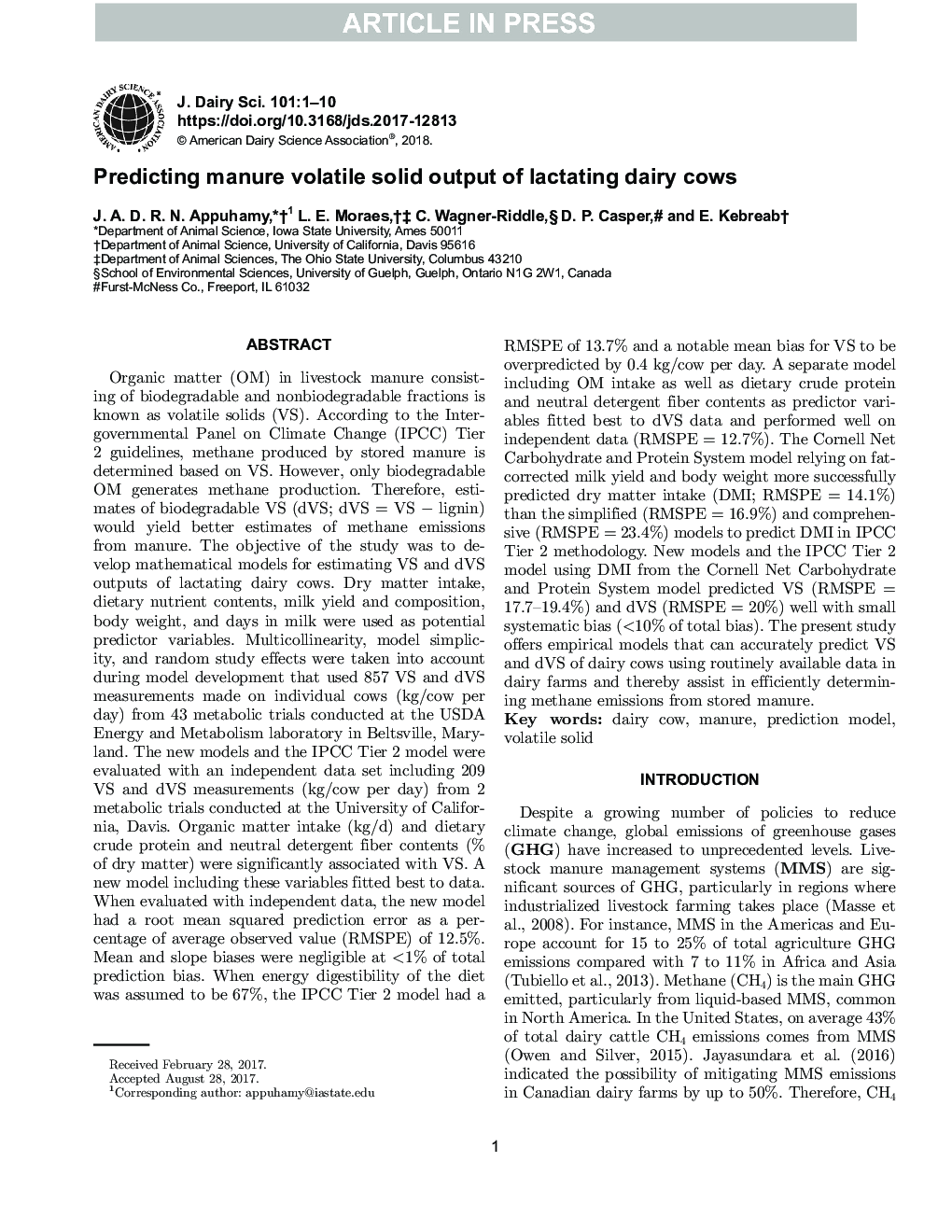| کد مقاله | کد نشریه | سال انتشار | مقاله انگلیسی | نسخه تمام متن |
|---|---|---|---|---|
| 8501809 | 1553844 | 2018 | 10 صفحه PDF | دانلود رایگان |
عنوان انگلیسی مقاله ISI
Predicting manure volatile solid output of lactating dairy cows
ترجمه فارسی عنوان
پیش بینی کود ناشی از تولید جامد گاو شیرده
دانلود مقاله + سفارش ترجمه
دانلود مقاله ISI انگلیسی
رایگان برای ایرانیان
کلمات کلیدی
گاو شیری، کود کشاورزی، مدل پیش بینی ثابت جامد،
موضوعات مرتبط
علوم زیستی و بیوفناوری
علوم کشاورزی و بیولوژیک
علوم دامی و جانورشناسی
چکیده انگلیسی
Organic matter (OM) in livestock manure consisting of biodegradable and nonbiodegradable fractions is known as volatile solids (VS). According to the Intergovernmental Panel on Climate Change (IPCC) Tier 2 guidelines, methane produced by stored manure is determined based on VS. However, only biodegradable OM generates methane production. Therefore, estimates of biodegradable VS (dVS; dVS = VS â lignin) would yield better estimates of methane emissions from manure. The objective of the study was to develop mathematical models for estimating VS and dVS outputs of lactating dairy cows. Dry matter intake, dietary nutrient contents, milk yield and composition, body weight, and days in milk were used as potential predictor variables. Multicollinearity, model simplicity, and random study effects were taken into account during model development that used 857 VS and dVS measurements made on individual cows (kg/cow per day) from 43 metabolic trials conducted at the USDA Energy and Metabolism laboratory in Beltsville, Maryland. The new models and the IPCC Tier 2 model were evaluated with an independent data set including 209 VS and dVS measurements (kg/cow per day) from 2 metabolic trials conducted at the University of California, Davis. Organic matter intake (kg/d) and dietary crude protein and neutral detergent fiber contents (% of dry matter) were significantly associated with VS. A new model including these variables fitted best to data. When evaluated with independent data, the new model had a root mean squared prediction error as a percentage of average observed value (RMSPE) of 12.5%. Mean and slope biases were negligible at <1% of total prediction bias. When energy digestibility of the diet was assumed to be 67%, the IPCC Tier 2 model had a RMSPE of 13.7% and a notable mean bias for VS to be overpredicted by 0.4 kg/cow per day. A separate model including OM intake as well as dietary crude protein and neutral detergent fiber contents as predictor variables fitted best to dVS data and performed well on independent data (RMSPE = 12.7%). The Cornell Net Carbohydrate and Protein System model relying on fat-corrected milk yield and body weight more successfully predicted dry matter intake (DMI; RMSPE = 14.1%) than the simplified (RMSPE = 16.9%) and comprehensive (RMSPE = 23.4%) models to predict DMI in IPCC Tier 2 methodology. New models and the IPCC Tier 2 model using DMI from the Cornell Net Carbohydrate and Protein System model predicted VS (RMSPE = 17.7-19.4%) and dVS (RMSPE = 20%) well with small systematic bias (<10% of total bias). The present study offers empirical models that can accurately predict VS and dVS of dairy cows using routinely available data in dairy farms and thereby assist in efficiently determining methane emissions from stored manure.
ناشر
Database: Elsevier - ScienceDirect (ساینس دایرکت)
Journal: Journal of Dairy Science - Volume 101, Issue 1, January 2018, Pages 820-829
Journal: Journal of Dairy Science - Volume 101, Issue 1, January 2018, Pages 820-829
نویسندگان
J.A.D.R.N. Appuhamy, L.E. Moraes, C. Wagner-Riddle, D.P. Casper, E. Kebreab,
